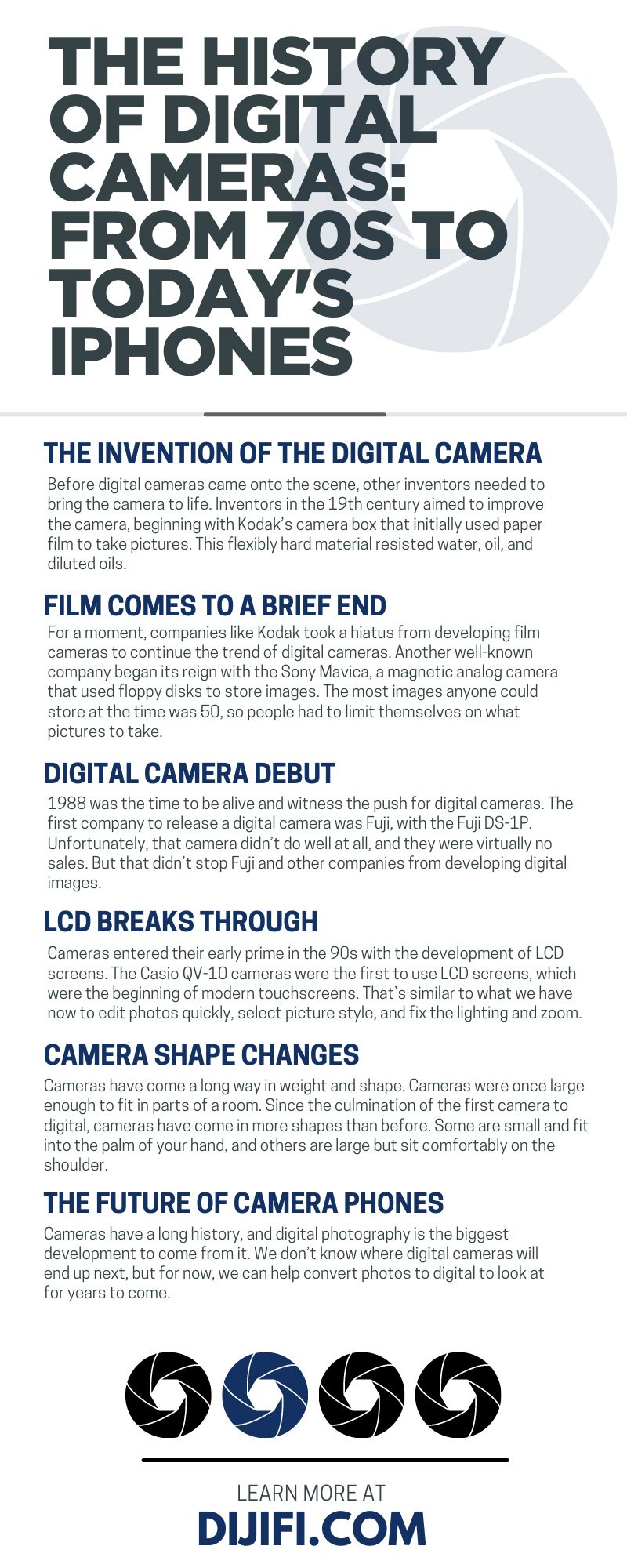The History of Digital Cameras: From 70s to Today's iPhones
Which came first—the still image or the motion picture? Many of us have this question, but so few know the answer. Everybody enjoys the convenience of having a smartphone with a built-in camera and editing tools close at hand. Before all smartphones had cameras built in, people had to carry digital cameras to record events.
Since the advancement of cameras today, the history of what happened before digital cameras got lost in the dark. Let’s unearth the history of digital cameras: from the 70s to today’s iPhones.
The Invention of the Digital Camera
Can you imagine the camera styles older family members and ancestors used back then? Before digital cameras came onto the scene, other inventors needed to bring the camera to life. Inventors in the 19th century aimed to improve the camera, beginning with Kodak’s camera box that initially used paper film to take pictures. This flexibly hard material resisted water, oil, and diluted oils.
Since the major change to celluloid, Kodak has been the household name when speaking on cameras. But it wasn’t until 1975 when Kodak engineer, Steve Sasson, invented the digital camera—and this primitive camera was the size of a toaster! The reason for its size was that it had to fit many different components so it could function.
The camera wasn’t the only thing blowing everyone’s minds around the 1970s; the camera’s manufacturing also drew curiosity. In the factory, workers built digital cameras from leftover kits and spare parts, including Motorola bits and CCD sensors, with a camera lens added to the design.
Film Comes to a Brief End
For a moment, companies like Kodak took a hiatus from developing film cameras to continue the trend of digital cameras. Another well-known company began its reign with the Sony Mavica, a magnetic analog camera that used floppy disks to store images. The most images anyone could store at the time was 50, so people had to limit themselves on what pictures to take.
Sony has since been a bigger name in the camera world, leading its victory to competitors like Canon, who developed the Canon Xapshot. This camera used electronic media for recording. Even though these camera types weren’t digital, they became the connection between the evolution of the digital camera and the innovations that followed.
Digital Camera Debut
A lot of media back then was limited to users, mainly because the technology needed to be tested and proven safe for the general public to use—kind of how the internet wasn’t made available to the general public until the 1990s.
1988 was the time to be alive and witness the push for digital cameras. The first company to release a digital camera was Fuji, with the Fuji DS-1P. Unfortunately, that camera didn’t do well at all, and they were virtually no sales. But that didn’t stop Fuji and other companies from developing digital images.
A lot of the reason cameras like Fuji didn’t do well initially was that consumers wanted better ways to save their recorded images; this began the development of JPEG and MPEG in 1988. In 1990, the Dycam Model 1 became the first official digital camera released on the market. This camera used a connecting cable that plugged right into computers for downloads. This was the moment the 90s became the early digital age.
Apple’s Try at Digital in the 90s
Straggling along in the 20th century was Apple. Apple is known as the brand for iPhones, iPads, and many other digital tablets that use cameras. Apple didn’t make a name for itself because of the phones, but rather, the company came to gain popularity because of pixels. Cameras back in the 70s had a megapixel value of 0.01, which took roughly 23 seconds to form an image after taking a picture.
Today, an Apple iPhone has 12 megapixels! That’s enough to take a picture in less than a millisecond. But wait, what amped the megapixels in Apple products like the famous iPhone? Apple did have a shot at blowing up the camera industry, and it did well! Apple released the QuickTake 100 in 1994, which cost less than $1,000.
What Was Great About Apple QuickTake 100?
First, Apple didn’t develop the camera alone, as the company had help from developers at Kodak. With Kodak’s assistance, Apple produced a camera with a pixel speed of 640x480. This camera stored up to 8 640x480 pictures at one time. Although the digital camera film was limited, it still brought prominence to the brand; a follow-up, the QuickTake 200, was created by FujiFilm.
LCD Breaks Through
Cameras entered their early prime in the 90s with the development of LCD screens. The Casio QV-10 cameras were the first to use LCD screens, which were the beginning of modern touchscreens. That’s similar to what we have now to edit photos quickly, select picture style, and fix the lighting and zoom.
Camera Shape Changes
Cameras have come a long way in weight and shape. Cameras were once large enough to fit in parts of a room. Since the culmination of the first camera to digital, cameras have come in more shapes than before. Some are small and fit into the palm of your hand, and others are large but sit comfortably on the shoulder.
Now, digital cameras come in all sizes, and enhancements keep improving, such as the LCD screen and the lens. Once upon a time, there was a point where you had to press down firmly to open an operation, but now, the swipe or slight touch of a finger opens apps and other camera functions easily.
The Future of Camera Phones
The history of cameras from the 70s to today’s iPhone doesn’t end here. Cameras get better as time passes, but those pictures you take remain forever, and they are yours to cherish for a long time. Digital cameras have gone from disposable handheld cameras from Kodak to Canon’s professional, lightweight camera that is easy to tote around on vacation or out with friends. Now, cameras are easier to carry and place in your pocket.
Cameras have a long history, and digital photography is the biggest development to come from it. We don’t know where digital cameras will end up next, but for now, we can help convert photos to digital to look at for years to come.


